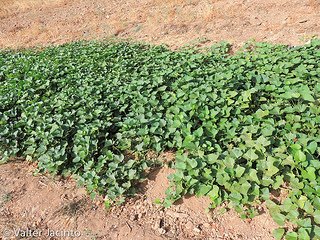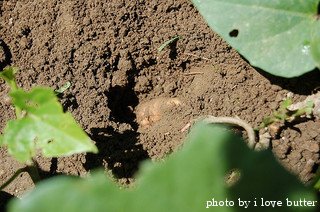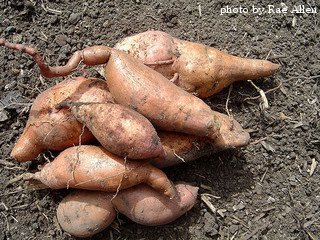Watering and Fertilizing Sweet Potatoes
Before fertilizing sweet potatoes, it's a good idea to wait until the slips have had a chance to establish themselves. Once their root systems have taken hold, they do a better job of absorbing nutrients.
Watering Sweet Potatoes

Sweet
potato plants do well with 3/4-1 inch of rain per week. Without enough
water, the potato growth will be stunted and you'll end up with some
puny tubers. Additionally, they may be slightly deformed and not as
sweet or tender.
It's a good idea to water in the early morning
hours. This gives the afternoon sun a chance to evaporate any unused
water off the foliage. Wet foliage is a breeding ground for fungal and
bacterial infections. The drier the sweet potato vines stay, the
better. A long soak once a week if there's no rain should be plenty.
Avoid several shallow waterings - the water just doesn't get deep enough
to where the roots can absorb it efficiently. If in doubt about
whether to water you sweet potato plants, dig down about 4 inches in to
the soil with your fingers. If the soil is dry, go ahead and water. If
it's soggy, hold off and let the ground dry out a bit.
It's
usually not necessary to mulch around sweet potato plants as the vines
spread out and do a pretty good job of keeping the weeds down and
keeping the soil moist.
Stop watering sweet potato plants
altogether a couple of weeks before they are to be harvested. Usually,
when the vines begin to turn yellow, it's a sign to stop watering. This
will allow the sweet potatoes time to fully mature and concentrate
their sugars.
Fertilizing Sweet Potatoes

Choose a fertilizer with potassium and phosphate levels that are
higher than nitrogen levels. Pay attention to the 3 number code on the
bag of fertilizer. These three numbers indicate the amount of nitrogen,
phosphate and potassium that are contained in that particular
fertilizer, respectively. For instance, a 10-10-10 fertilizer contains
10% nitrogen, 10% phosphate and 10% potassium. A 5-10-10 bag would
contain 5% nitrogen, 10% phosphate and 10% potassium. Nitrogen
encourages a plant to produce more foliage. Phosphate and potassium
encourages more root development. Because potatoes are a root vegetable
that grows below the surface of the soil, phosphate and potassium are
more beneficial to potato growth. A fertilizer formula of 5-10-10 or
8-24-24 works well for sweet potatoes.
You can begin fertilizing
sweet potatoes about 2 weeks after transplanting them into your garden.
After that, they can be fertilized every 4-6 weeks during the growing
season. Stop fertilizing about 3 weeks before they are harvested.
Generally, 3 doses of fertilizer throughout the growing season are
sufficient.
We prefer to use a water-soluble product for fertilizing sweet potatoes. Granular fertilizer is fine while the plants are still small. But if it comes in contact with the plants, it can burn them. As the plants grow and start to spread out, it's just much easier to apply a fertilizer you can mix into water. In addition, you can use a water-soluble fertilizer during your regular watering routine, which is less time-consuming, especially if you have a hose-end sprayer.
Click on the following links to learn more about harvesting and eating sweet potatoes.

Click here to learn about harvesting sweet potatoes
Click here for some of our favorite sweet potato recipes
Click here to move from our Fertilizing Sweet Potatoes page to our Growing Sweet Potatoes main page
Click here to go to our Home page